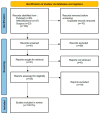Music Therapy for Managing Dental Anxiety in Children: A Systematic Review and Meta-Analysis of Clinical Evidence
- PMID: 41153564
- PMCID: PMC12563863
- DOI: 10.3390/children12101382
Music Therapy for Managing Dental Anxiety in Children: A Systematic Review and Meta-Analysis of Clinical Evidence
Abstract
Background: Dental anxiety is a common challenge in paediatric dentistry, often leading to avoidance of treatment and compromised oral health. Non-pharmacological interventions such as music therapy have gained increasing attention as safe and cost-effective alternatives to pharmacological approaches. Although several clinical studies have examined the impact of music on children's dental anxiety, the evidence has not yet been systematically summarised with quantitative synthesis. Objective: This systematic review and meta-analysis aimed to evaluate the effectiveness of music therapy in reducing dental anxiety and fear among paediatric patients. Methods: A comprehensive literature search was conducted in PubMed, Scopus, Web of Science, and Cochrane Library from inception to August 2025. Randomised controlled trials (RCTs) evaluating music therapy for dental anxiety in children were included. Primary outcomes were self-reported dental anxiety/fear scales and physiological measures (heart rate, blood pressure, oxygen saturation). Risk of bias was assessed using the revised Cochrane risk of bias tool (RoB 2, version 2019; Cochrane Collaboration, London, UK) Meta-analyses were performed using a random-effects model with Review Manager (RevMan, version 5.4; Cochrane Collaboration, London, UK). Results: Seven randomized controlled trials (RCTs) involving 476 children aged 4-14 years were included. Music therapy significantly reduced self-re-ported dental anxiety compared with control groups (SMD = -0.48, 95% CI: -0.72 to -0.25, p < 0.001). Heart rate was also significantly reduced (SMD = -0.42, 95% CI: -0.68 to -0.16, p = 0.002), whereas changes in blood pressure and oxygen saturation were not statistically significant. The overall risk of bias was moderate, with most concerns related to blinding. Conclusions: Music therapy is an effective non-pharmacological intervention to reduce dental anxiety in children, particularly improving subjective anxiety and physiological arousal as measured by heart rate. Its integration into paediatric dental practice may enhance cooperation and treatment outcomes, offering a safe, inexpensive, and child-friendly approach.
Keywords: behavior therapy; child; child cooperation; dental anxiety; meta-analysis as topic; music therapy; non-pharmacological interventions; pediatric dentistry; physiological stress markers; systematic reviews as topic.
Conflict of interest statement
The authors declare no conflicts of interest.
Figures





References
Publication types
LinkOut - more resources
Full Text Sources

